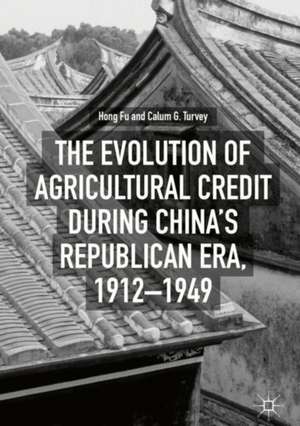The Evolution of Agricultural Credit during China’s Republican Era, 1912–1949
Autor Hong Fu, Calum G. Turveyen Limba Engleză Hardback – 11 iun 2018
In the modern era, China’s rural credit landscape is transforming at a dizzying rate, but, in terms of financial development, these changes represent a second attempt in the past 100 years to reform China’s credit institutions and provide credit access to farmers. The first period was during the Republican era, between 1912 and 1949, which saw the first attempts at formalizing rural credit with the Industrial and Agricultural Banks. This book uses primary data and papers to present a full picture of the difficult conditions China faced during the Republican era in order to explain the myriad reforms to the country's rural credit system. Fu and Turvey build a narrative around these developments based on the foundation of thousands of years of dynastic rule in order to explore the specific impacts of drought, floods, famine, communist insurgencies, Japanese expansionism, and more on credit access, supply and demand. They consider powerful personalities—such as J.B. Taylor, John Lossing Buck, Paul Hsu and Timothy Richards—and influential institutions—from Nanking and Nankai Universities to the China International Famine Relief Commission—that sought ways to end the cycle that trapped the vast majority of Chinese farmers in poverty. This rich, wide-ranging, and stimulating work will appeal both to readers focused on present day China and those who want to understand China’s rural economy and credit policies in a historical context.
| Toate formatele și edițiile | Preț | Express |
|---|---|---|
| Paperback (1) | 997.68 lei 6-8 săpt. | |
| Springer International Publishing – 8 ian 2019 | 997.68 lei 6-8 săpt. | |
| Hardback (1) | 1003.04 lei 6-8 săpt. | |
| Springer International Publishing – 11 iun 2018 | 1003.04 lei 6-8 săpt. |
Preț: 1003.04 lei
Preț vechi: 1223.22 lei
-18% Nou
Puncte Express: 1505
Preț estimativ în valută:
191.94€ • 205.24$ • 160.03£
191.94€ • 205.24$ • 160.03£
Carte tipărită la comandă
Livrare economică 17 aprilie-01 mai
Preluare comenzi: 021 569.72.76
Specificații
ISBN-13: 9783319768007
ISBN-10: 331976800X
Pagini: 356
Ilustrații: XXIX, 419 p. 38 illus.
Dimensiuni: 148 x 210 x 27 mm
Greutate: 0.69 kg
Ediția:1st ed. 2018
Editura: Springer International Publishing
Colecția Palgrave Macmillan
Locul publicării:Cham, Switzerland
ISBN-10: 331976800X
Pagini: 356
Ilustrații: XXIX, 419 p. 38 illus.
Dimensiuni: 148 x 210 x 27 mm
Greutate: 0.69 kg
Ediția:1st ed. 2018
Editura: Springer International Publishing
Colecția Palgrave Macmillan
Locul publicării:Cham, Switzerland
Cuprins
1. Current Conditions of Rural Credit in China.- 2. China’s Sorrow.- 3. Low-Level Equilibrium and Fractional Poverty Traps.- 4. Traditional Forms of Credit in Rural China.- 5. Emergence of Modern Rural Financial Institutions in the Warlord Era: 1912–28.- 6. Estimating the Demand for Farm Credit in the Republican Era.- 7. The China International Famine Relief Commission.- 8. Rural Reconstruction.- 9. A Blueprint for Credit under Rural Reconstruction.- 10. Evolution of Cooperative Financial System: 1927–49.- 11. Chinese Communists, Border Currency, and Agricultural Credit during Wartime.- 12. The Farmers Bank of China.- 13. Nong Ben Ju, the Farm Credit Bureau, and KMT’s Agrarian Policy.- 14. Successes and Failures of Agricultural Cooperatives and Credit Societies.
Notă biografică
Hong Fu is Associate Professor at Shandong University of Finance and Economics, China. Her research interests include economic history, rural finance and crop insurance.
Calum G. Turvey holds the W.I. Myers Professorship of Agricultural Finance in the Charles H. Dyson School of Applied Economics and Management, Cornell SC Johnson College of Business and College of Agriculture and Life Sciences, Cornell University, USA.
Textul de pe ultima copertă
In the modern era, China’s rural credit landscape is transforming at a dizzying rate, but, in terms of financial development, these changes represent a second attempt in the past 100 years to reform China’s credit institutions and provide credit access to farmers. The first period was during the Republican era, between 1912 and 1949, which saw the first attempts at formalizing rural credit with the Industrial and Agricultural Banks. This book uses primary data and papers to present a full picture of the difficult conditions China faced during the Republican era in order to explain the myriad reforms to the country's rural credit system. Fu and Turvey build a narrative around these developments based on the foundation of thousands of years of dynastic rule in order to explore the specific impacts of drought, floods, famine, communist insurgencies, Japanese expansionism, and more on credit access, supply and demand. They consider powerful personalities—such as J.B. Taylor, John Lossing Buck, Paul Hsu and Timothy Richards—and influential institutions—from Nanking and Nankai Universities to the China International Famine Relief Commission—that sought ways to end the cycle that trapped the vast majority of Chinese farmers in poverty. This rich, wide-ranging, and stimulating work will appeal both to readers focused on present day China and those who want to understand China’s rural economy and credit policies in an historical context.
Caracteristici
Provides new insights into the economics of agricultural credit in peasant economies Explores the evolution of agricultural credit in China through a historical perspective Features data from primary sources from the Republican era in China Analyzes developments in agricultural credit and rural credit cooperatives
